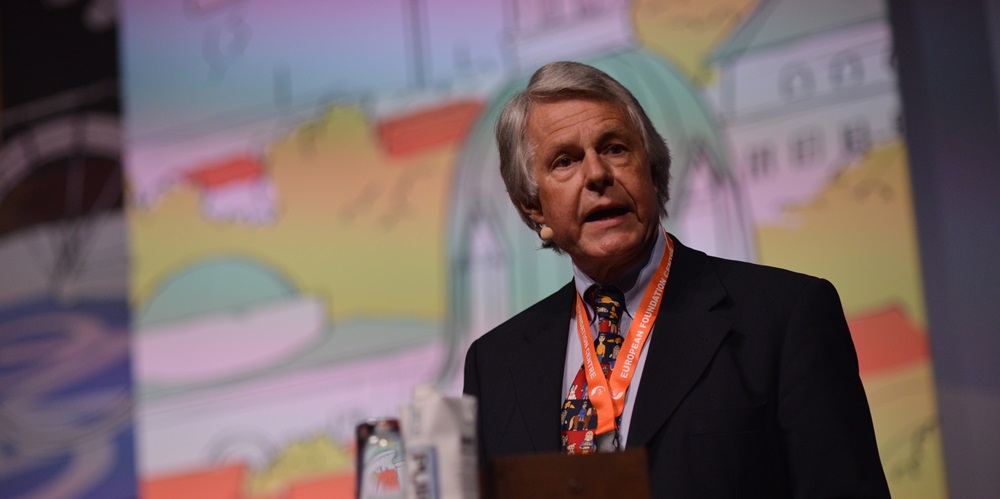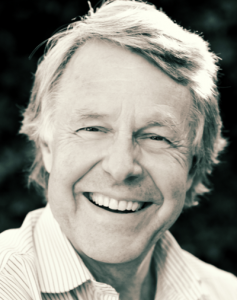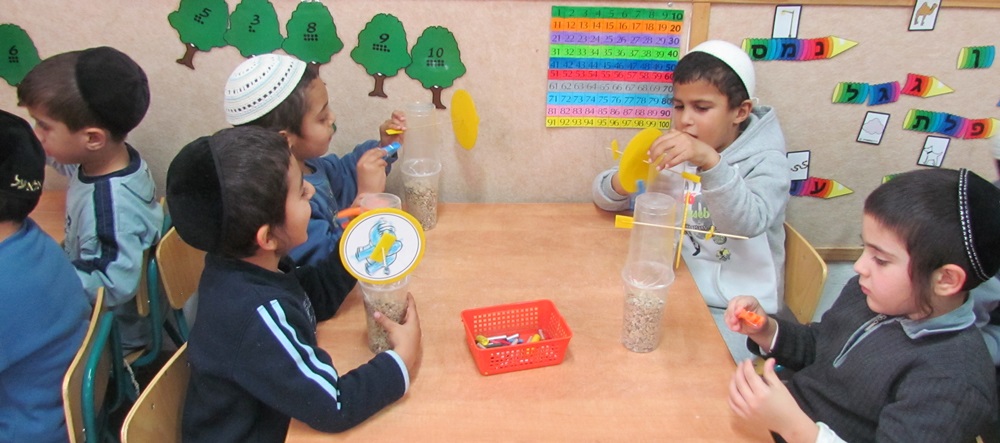The Long View
Fewer people are better placed than Rien Van Gendt to give an informed perspective on where philanthropy has been and where it is going. Not only is he a veteran of European philanthropy, having seen it through so many evolutions, he combines this with experience of business and politics. He takes Alliance’s Acting Editor, Charles Keidan, on a tour of that experience, talking about the development of relations between US and European foundations, about the new Dutch foundation charter, about new alliances, about government’s growing recognition of philanthropy’s contribution and about the importance – and difficulties – of working in conflict zones.
You’ve been involved in philanthropy for a long time. What do you think are the most memorable and important roles you’ve played?
I think one of them was the role I played in the Bernard van Leer Foundation that was acknowledged in 2005 with the Distinguished Grantmaker Award. Foundation News and Commentary, which is the magazine of the Council on Foundations had an interview with me in 1991 and they were surprised that a Dutch foundation at that time was taking, first of all, a very international approach – 95 per cent of its resources were spent outside the country where it was based – but also that we used the cheque as an instrument for a strategy, that we paid ample attention to monitoring, to evaluation, to distilling knowledge that we got from our field work, and sharing it.
The other thing for me is the development of the US-Europe relationship and the international willingness to work together with the multilaterals, too. I think I was instrumental in both of these when I was the head of van Leer, but also as chair of the international committee of the European Foundation Centre, which I combined with being the chair of the International Committee of the Council on Foundations. It was at the time that the Patriot Act came into force in the US. The country took a much more domestic perspective and created hurdles for international grantmaking. For me, it was the time to reach out to US foundations and say, ‘why don’t we work together outside Europe and the US?’ And many programmes in Latin America and in Africa were the result of that. Around the same time, I also initiated the contact with the World Bank when Jim Wolfensohn was its president and Mark Malloch Brown who later became the Director of the UNDP, was also there and, out of that came some interesting programmes, too.
In an interview you gave to Alliance in 2005, you mentioned some of the specific roles that foundations played with respect to the Millennium Development Goals (MDGs) – their ability to engage with civil society through networks and contacts, the qualitative engagement that you saw foundations could offer, the ability to lobby and form opinions and the ability to shift philanthropy to being more international in orientation. However, you expressed some frustration that the rhetoric about doing this was more advanced than the practice. Do you have any reflections on both the Millennium Development Goals, and going forward, the Sustainable Development Goals?
With both the MDGs and the SDGs, it is hard for foundations to become involved in the bureaucratic process, and I think it’s more important for us to look at innovative partnerships in the implementation process and at innovative solutions. I see there is scope there and much more willingness on the part of governments, corporates and multilaterals to reach out to the foundation community than there was when the Millennium Development Goals were drafted.
There is an element here I want to emphasize. I was involved in a public discussion about the SDGs in the Netherlands with the Minister of Development Aid and some corporate leaders. Obviously, the amount of money the government and even the corporate world can put in is so massive that we are like a drop in the ocean. But the point that I made, and which was acknowledged, is that we can take the risks that you never can take. Public accountability prevents governments from doing the kind of things that we can do. And we can play that distinct role in many areas – addressing climate change, fighting poverty, and so on. That was so in the 1990s, but now, governments see it, too. So in the Netherlands there has been a Charter [the Space for Private Giving Charter – see below] signed, and the foundation community is playing an important role.
Do you see any examples of foundations taking risks in relation to the SDGs?
There is a programme at the moment in Ethiopia in the health area, where some Dutch foundations are putting up the money to explore new approaches to community health systems that for the government would be difficult to do. Another good example is the organization Partners in Health where I am on the board that works with communities. There are things being done with private money in countries like Burundi, in Ethiopia, in Haiti that the government could not do, but governments can scale up successful experiments. That happened with a programme van Leer did in rural China on using natural resources for learning. It was subsequently used by the Asian Development Bank (ADB) and the Chinese government but the first money would never have been put in by a government.
In your article on the Sustainable Development Goals in the December 2015 edition of Alliance, you talked about foundations being part of government trade missions, as a sign of the developing relationship between Dutch foundations and government. Could you say a little bit more about that, because it seems quite unusual?
It is quite unusual. It’s been an argument of mine for a long time that people don’t differentiate between endowed foundations and charities and, consequently, neither does legislation. So, a couple of years ago, we were as philanthropic sector invited by the Prime Minister to organize a meeting between seven wealthy families in the Netherlands and six or seven members of the cabinet. The families explained why they were putting their wealth into a foundation and what the hurdles were. This resulted in two initiatives – one was a joint task force from the Ministry of Finance and the sector to investigate the fiscal and legal regime for foundations and the other came from the Minister of Development Aid and Trade, Lilianne Ploumen. She wanted to explore the idea of foundations joining trade missions, because when visiting companies in other countries, she came across an interest in philanthropy, and thought maybe the Netherlands had something to offer on that score.
How many have there been?
A few, among others, to India and Bangladesh. And now, whenever there is one, we are approached to see whether we want to join or whether we can introduce the minister to local philanthropy. It is early on of course, but I think it has huge potential.
And does everyone pay their own way? They share the same flight?
Exactly.
And would it be alongside business figures? So you’d have your group that was focussed on philanthropy and others that are focussed on business or is it that the two are interrelated?
It is interrelated. It is early on of course, but the feeling is that we have something to offer looking at the blended value of financial and social return and engagement I think it has a huge potential.
And coming back to the meeting with the Dutch PM, what was his response when he met with those seven representatives of philanthropic families?
Well, although he was aware of it, he was actually flabbergasted when he met the people. Another thing I look at with great satisfaction is that in my role as the Chair of the Dutch Association of Foundations, I started visiting the Secretary Generals (the highest civil servant within a Ministry) of individual Ministries, saying ‘are you aware of what is happening with private money in this country in your domain?’ The first was the Ministry for Environment and Inner Cities. He wasn’t aware at all that there was private money doing fantastic things, so he invited me to make a presentation to the Director Generals of the various departments. And I followed up with the Ministry of Education, the Ministry of Economic Affairs and finally with the Prime Minister’s office. And that led to the Covenant. So I think we have been quite successful in drawing attention to the important role the sector plays. That is not an excuse for the government to withdraw and the point that I constantly make is that we should work in partnership, whenever that is seen by us as foundations as appropriate.
Can we talk more about that Covenant? I understand it contains a commitment to develop a process of foundation transparency, in return for foundations being allowed to retain their independence. How did that develop?
It was not in return for independence, because foundation independence was an assumption. The trade-off was between transparency and us being involved in new legislation. We see legislation before it is presented to parliament, to see whether there are elements that could be formulated in a better way on the understanding that we make a real effort at greater transparency and accountability and we are in the last stages of formulating a code of conduct for good governance. We have also distilled from that code some norms which provide the basis for oversight. The elements are distinct. The norms are formulated by the sector itself, will be declared applicable to the whole sector by the government, and a separate private institution that has the legal form of a foundation with an independent board will do the oversight. Now, this was a very long process, but we actually passed its main architecture unanimously a few months ago.
You were also involved with formulating the ‘Principles of Good Practice’ at the European Foundation Centre. Did that help prepare the ground, knowing what had been developed more broadly in Europe for the Dutch context?
Exactly. For public charities it’s easy, because you want to be transparent to your donors, to the general public. But what motives do endowed foundations have to become transparent to the general public? The compelling arguments to them to comply are: you become a better foundation if you become more transparent, it will be easier to make partnerships, you will get higher quality proposals when people know what you are doing and you can inspire others to do the same as you do. Ultimately, the Dutch foundations were convinced and saw that you can professionalize by having a good code of conduct and norms and appropriate oversight. The key condition was to avoid having a public institution doing the oversight.
Thinking outside the Dutch and even European context, I wanted to ask you about two particular areas. One is about the growth of interest in philanthropy research and education. How do you see that developing?
I see a need for research because the role of philanthropy is becoming more important – governments are retreating, there is political fragmentation, foundations are increasingly visible and they are becoming more interested in the root causes. What comes with this is partnership among foundations. A group of foundations in the Netherlands is working on ageing and before they started to invite NGOs to submit proposals, they did research about what is important here. I see the same thing with migration. Before you start funding, there is increasing need for underpinning, for research. Are the universities in a position to deliver? Once, foundations would be more likely to turn to McKinsey or Roland Berger than to a university, but I think universities have made great progress – the Erasmus Centre for Strategic Philanthropy is doing some terrific work in that respect and the Vrije University and Maastricht, among others.
What kind of questions do you think universities are best placed to answer about philanthropy?
One set of questions is related to the substance of foundations’ work. An example is when the van Leer Foundations started a new programme on child abuse, it was important to have universities involved to map out exactly where the problems were. Another example would be research about the most effective form of development cooperation. And then there are of course the set of questions that deal with the craft of grant making, with procedures, with transparency, with financing. What are the new forms of funding, and so on?
During my sabbatical research on philanthropy education in Europe, one of the developments I noticed was an increase in training and executive education being provided by universities, including in Holland.
Yes and an important element there is good governance, and so both the Vrije University and Erasmus has those programmes to offer training on being a board member. We don’t have an organization like Board Source in Europe, but fortunately the universities are stepping in.

Rien van Gendt receives the Compass Prize at the EFC AGA and Conference 2013 in Copenhagen (European Foundation Centre)
So your answer would be very much that philanthropy can and should be taught?
Oh, yes. And studied.
My final question relates to funding in conflict situations. I’m thinking specifically about van Leer’s work in Israel and Palestine. What do you see as the opportunities and challenges of working in particular in that context, or more generally in conflict areas, and how can foundations navigate that territory?
Van Leer has a number of initiatives in Israel, both on the Jewish and the Arab-Israeli side and we also had programmes in the past in the West Bank. We have the van Leer Jerusalem Institute, which is a centre for advanced studies in the humanities, which is doing interesting work. We have the Jerusalem Film Centre, which has an education programme, and also has always been involved in building bridges, entering into dialogue. And although it was difficult, and still is difficult, it is in my opinion, so important that that work continues.
If I take the work of the van Leer Jerusalem Institute, it brings together people of the same profession. Even if there is an intifada, people respect and reach out to each other. So that work is so valuable. But also both in the van Leer Jerusalem Institute and in the Bernard van Leer Foundation, we have worked in Bnei Brak, in the very fundamentalist Jewish communities, where people recited the Torah in schools and we offer them a broader orientation on the world, in terms of history and sociology. So we have always tried to be creative in Israel. But we have also worked in countries like Morocco and Kenya, bringing secular dimensions into Quranic schools. So areas where there is tension between communities has always has been an element van Leer has been strongly involved in and I have supported it. I have also taken on a new initiative in the Netherlands on migration for the organization called Major Alliance, and one of the elements I would like to address is the view in Dutch society of migration and how you can change it. I was on the board of SIRE which is the equivalent of the advertising council in the US. It is a non-profit that brings messages to society in all kinds of different ways. Behind this are the pro bono activities of commercial PR offices, and I would like to engage them in the narrative on refugees.
Just to return to Israel-Palestine situation. I understand and sympathize with the creative approach you outline, but the situation has become worse so how does one measure the impact of all the money that’s invested when tensions seem to be growing, rather than decreasing?
You can’t. You can document what you are doing by going back to the communities you have worked in or to the people you have worked with, but it is complicated to assess impact if you work on something as intangible as the alleviation of tension. You have to trust your belief and conviction that you do the right thing. In that context I have always felt in Israel how important it is to have independent, private money to do risky things How successful is it? I can only tell you that we were asked two years ago to draft the bill on civil society. It was drafted inside the van Leer Jerusalem Institute, and that never would have happened if we had not done all the other initiatives, that are less tangible. Apparently Van Leer in Israel was viewed as an authority. And maybe now more than ever, under difficult circumstances, it is important that we continue, while taking risks that you don’t know whether you will be successful.
And talking of taking risks, has the Foundation considered going one step further and working not just in the West Bank, but also in Gaza?
Not at this moment. We did many years ago, but that was before Hamas was elected in Gaza, so we have focussed inside Israel, on Arab-Israelis and Bedouins next to the Jewish population. We have even stopped many years ago the activities in the West Bank, but that had more to do with our resources and the fact that we reduced the number of countries where we worked from 40 to around 10.
Do you have any closing reflections on what should change in philanthropy or what needs to be developed?
With a problem of the magnitude and nature of migration, I would hope, and fortunately I see also, that foundations are not hiding behind the strict formulation of their mission, but are prepared to say ‘how can we come in collectively?’ So I see partnerships emerging around the issue of migration, and with the emphasis on the mid-term and long-term aspects, not just the immediate response – how you can properly integrate people, looking at micro-credit schemes for migrants, the acknowledgement of diplomas, fighting trauma, health, social cohesion, and civic education. And, contrary to the arguments of the past that ‘it doesn’t fit into my mandate’, many foundations are now saying, ‘if our founder still was alive, he would have adapted the mandate.’
You’ve worked in government, in business and in philanthropy. In which of the three do you think is the greatest potential to affect the kinds of changes you’ve been talking about?
I think it is in business and in philanthropy. The role of government is changing. There is a distrust of government, there is political fragmentation, with single-issue parties coming to the fore. It’s difficult to formulate compromises in coalition governments because nobody takes ownership of them, so governments are becoming more interested in formulating the boundary factors and facilitating procedures. So the innovative power could come from civil society, and also from corporates, although at the same time I became a bit cynical when I saw what Volkswagen were up to. It made me wonder ‘has this been lip service’? How genuine is the whole debate about sustainability?’ On the other hand, there are so many social enterprises in this country, small enterprises that have a blended value approach to social and financial return, that I think that we will witness real change there.





Comments (0)